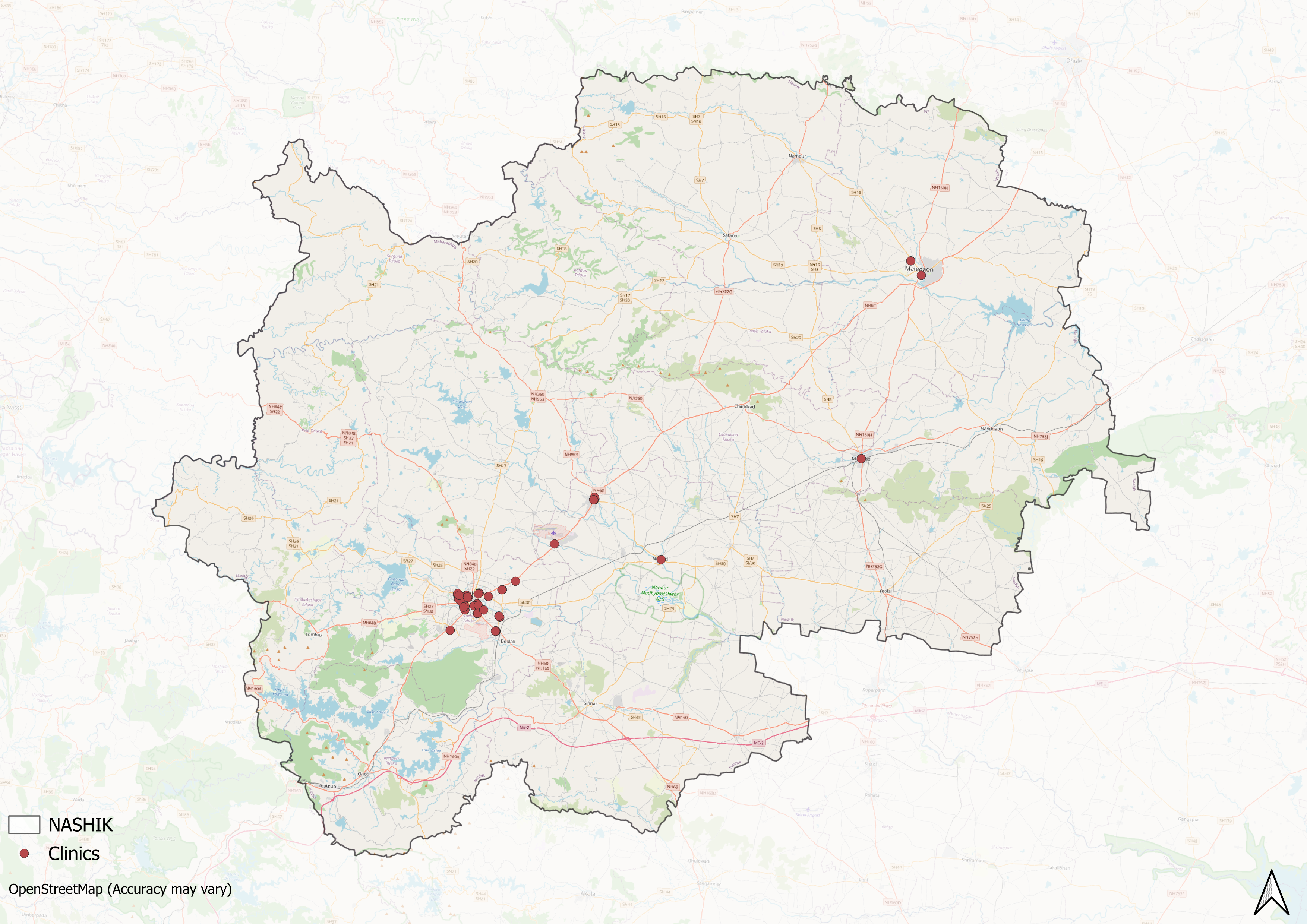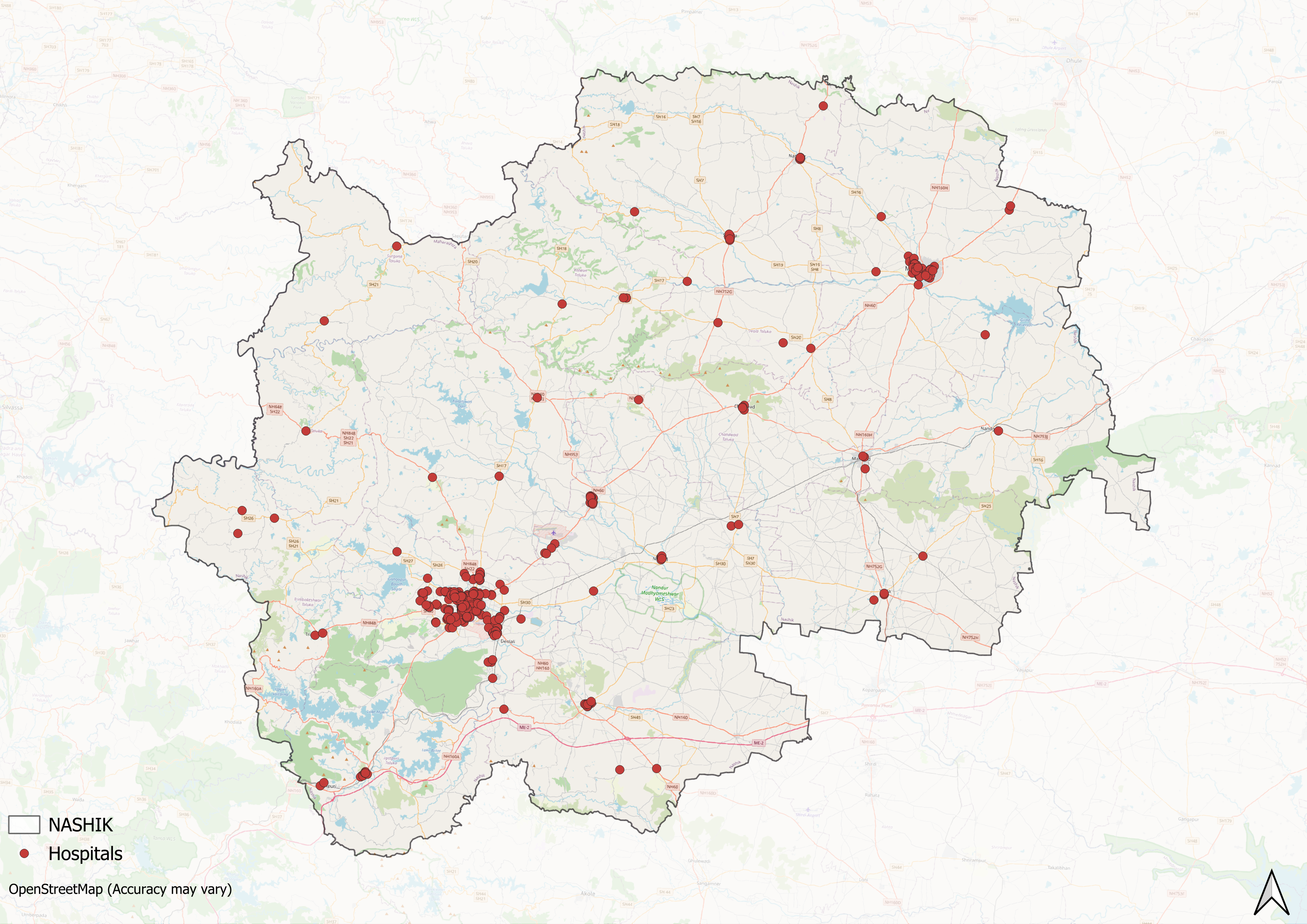Contents
- Healthcare Infrastructure
- Medical Education & Research
- Maharashtra University of Health Sciences
- Graphs
- Healthcare Facilities and Services
- A. Public and Govt-Aided Medical Facilities
- B. Private Healthcare Facilities
- C. Approved vs Working Anganwadi
- D. Anganwadi Building Types
- E. Anganwadi Workers
- F. Patients in In-Patients Department
- G. Patients in Outpatients Department
- H. Outpatient-to-Inpatient Ratio
- I. Patients Treated in Public Facilities
- J. Operations Conducted
- K. Hysterectomies Performed
- L. Share of Households with Access to Health Amenities
- Morbidity and Mortality
- A. Reported Deaths
- B. Cause of Death
- C. Reported Child and Infant Deaths
- D. Reported Infant Deaths
- E. Select Causes of Infant Death
- F. Number of Children Diseased
- G. Population with High Blood Sugar
- H. Population with Very High Blood Sugar
- I. Population with Mildly Elevated Blood Pressure
- J. Population with Moderately or Severely High Hypertension
- K. Women Examined for Cancer
- L. Alcohol and Tobacco Consumption
- Maternal and Newborn Health
- A. Reported Deliveries
- B. Institutional Births: Public vs Private
- C. Home Births: Skilled vs Non-Skilled Attendants
- D. Live Birth Rate
- E. Still Birth Rate
- F. Maternal Deaths
- G. Registered Births
- H. C-section Deliveries: Public vs Private
- I. Institutional Deliveries through C-Section
- J. Deliveries through C-Section: Public vs Private Facilities
- K. Reported Abortions
- L. Medical Terminations of Pregnancy: Public vs Private
- M. MTPs in Public Institutions before and after 12 Weeks
- N. Average Out of Pocket Expenditure per Delivery in Public Health Facilities
- O. Registrations for Antenatal Care
- P. Antenatal Care Registrations Done in First Trimester
- Q. Iron Folic Acid Consumption Among Pregnant Women
- R. Access to Postnatal Care from Health Personnel Within 2 Days of Delivery
- S. Children Breastfed within One Hour of Birth
- T. Children (6-23 months) Receiving an Adequate Diet
- U. Sex Ratio at Birth
- V. Births Registered with Civil Authority
- W. Institutional Deliveries through C-section
- X. C-section Deliveries: Public vs Private
- Family Planning
- A. Population Using Family Planning Methods
- B. Usage Rate of Select Family Planning Methods
- C. Sterilizations Conducted (Public vs Private Facilities)
- D. Vasectomies
- E. Tubectomies
- F. Contraceptives Distributed
- G. IUD Insertions: Public vs Private
- H. Female Sterilization Rate
- I. Women’s Unmet Need for Family Planning
- J. Fertile Couples in Family Welfare Programs
- K. Family Welfare Centers
- L. Progress of Family Welfare Programs
- Immunization
- A. Vaccinations under the Maternal and Childcare Program
- B. Infants Given the Oral Polio Vaccine
- C. Infants Given the Bacillus Calmette Guerin (BCG) Vaccine
- D. Infants Given Hepatitis Vaccine (Birth Dose)
- E. Infants Given the Pentavalent Vaccines
- F. Infants Given the Measles or Measles Rubella Vaccines
- G. Infants Given the Rotavirus Vaccines
- H. Fully Immunized Children
- I. Adverse Effects of Immunization
- J. Percentage of Children Fully Immunized
- K. Vaccination Rate (Children Aged 12 to 23 months)
- L. Children Primarily Vaccinated in (Public vs Private Health Facilities)
- Nutrition
- A. Children with Nutritional Deficits or Excess
- B. Population Overweight or Obese
- C. Population with Low BMI
- D. Prevalence of Anaemia
- E. Moderately Anaemic Women
- F. Women with Severe Anaemia being Treated at an Institution
- G. Malnourishment Among Infants in Anganwadis
- Sources
NASHIK
Health
Last updated on 26 July 2025. Help us improve the information on this page by clicking on suggest edits or writing to us.
Nashik’s healthcare landscape, like many other regions across India, is shaped by a mix of indigenous and Western medical practices. For centuries, indigenous knowledge and treatments provided by practitioners such as hakims and vaidyas have formed the foundation of healthcare in the region. People in the district also depended on plants, herbs, and other local resources to treat illnesses, which shaped the region’s early medical traditions. Over time, its landscape has gradually evolved with the introduction and expansion of more specialized medical services.
In recent years, healthcare has become one of the sectors for which Nashik is increasingly recognised. Local authorities have expressed plans to promote the city as a potential medical tourism hub.
Healthcare Infrastructure
Similar to other regions in India, Nashik’s healthcare infrastructure follows a multi-tiered system that involves both public and private sectors. The public healthcare system is structured into primary, secondary, and tertiary levels. Primary care is provided through Sub Centres and Primary Health Centres (PHCs), secondary care is managed by Community Health Centres (CHCs) and Sub-District hospitals, while tertiary care, the highest level, is delivered through Medical Colleges and District Hospitals.


Supporting this structure is a network of Accredited Social Health Activists (ASHAs) who, as described by the National Health Mission, serve as “an interface between the community and the public health system.” Over time, this multi-layered healthcare model has been continuously shaped and refined by national healthcare policies and reforms to improve universal health coverage across regions.
Nashik’s formal healthcare infrastructure, like much of India, has its origins in the colonial era, which laid the groundwork for the system in place today. According to the district Gazetteer (1969), the Nashik Civil Hospital was established in 1840 and mainly treated illnesses such as intestinal worms, dysentery, diarrhoea, skin diseases, malaria, and syphilis.
![Nashik Civil Hospital[1]](/media/statistic/images/maharashtra/nashik/health/nashik-civil-hospital1-5956aceb.png)
By 1881, the district’s public healthcare network had expanded to include seven additional dispensaries in Yeola, Malegaon, Dindori, Sinnar, Baglan, Peint, and Pimpalgaon in Niphad. Except for the Yeola dispensary, it is noted that each of these facilities operated from its own dedicated building.
Over time, the public health infrastructure continued to expand, and in the 20th century, new hospitals such as Harris General Hospital were added, which at the time became the largest hospital in the district. Harris General Hospital provided multiple specialist wards for dental care, eye treatment, ENT (ear, nose, and throat), tuberculosis (TB), and gynaecology. It also had facilities for family planning, child welfare, a referral laboratory, and a blood bank.
In the decades that followed, private hospitals began to play a larger role in Nashik’s healthcare system. Many were set up by local trusts, non-governmental organisations, and community groups to help meet rising demand. This growth also brought more specialised services, with cancer care emerging as a key area. For many patients, the cost of treatment in Nashik remains lower than in larger cities, leading more people to choose local care over travelling to Mumbai or Pune. Facilities such as the HCG Manavata Cancer Center now offer advanced oncology services and are part of this broader trend.
![HCG Manavata Cancer Center in Nashik[2]](/media/statistic/images/maharashtra/nashik/health/hcg-manavata-cancer-center-in-nashik2-02a8f5c7.png)
While the private sector expanded its reach, public hospitals also continued to add new services to address community needs. In 2024, Nashik District Hospital opened a dedicated ward for third gender patients, following Maharashtra’s first such ward in Mumbai a year earlier. The new ward provides life support services, surgeries, free diagnostic tests, and other treatment options, reflecting efforts to make public healthcare more inclusive.
Medical Education & Research
Medical education and research form a key component of Nashik’s healthcare landscape. The district is home to both public and private institutions that contribute to clinical training and health service delivery. Notably, something that stands out about Nashik when it comes to this field is that it serves as the headquarters of the Maharashtra University of Health Sciences (MUHS), established in 1998, which acts as the primary affiliating and regulatory body for medical education across the state.
Maharashtra University of Health Sciences
Maharashtra University of Health Sciences (MUHS) is a public medical university established in 1998 in Nashik. It serves as the primary affiliating body for health sciences education in the state.
![Maharashtra University of Health Sciences (MUHS)[3]](/media/statistic/images/maharashtra/nashik/health/maharashtra-university-of-health-sciences-muh_eL70r8y.png)
The university oversees undergraduate and postgraduate education in disciplines such as medicine, dentistry, Ayurveda, homeopathy, nursing, and allied health sciences. MUHS integrates both allopathic and traditional systems of medicine in its academic framework and plays a key role in standardizing medical education and promoting healthcare research across Maharashtra.
Graphs
Healthcare Facilities and Services
Morbidity and Mortality
Maternal and Newborn Health
Family Planning
Immunization
Nutrition
Sources
Chitra. 2024. "Nashik District Hospital Inaugurates Dedicated Care Room for Third Gender Patients." Lokmat Times. www.lokmattimes.com/maharashtra/nashik-district-hospital-inaugurates-dedicated-care-room-for-third-gender-patients-a505/https://www.lokmattimes.com/maharashtra/nash…
Gazetteers of Bombay Presidency. 1883 (reprinted 1994). Nasik District. Vol XVI. Gazetteer Department, Government of Maharashtra, Mumbai.https://archive.org/details/in.ernet.dli.201…
Government of Maharashtra. "Hospitals." Nashik District Official Website. nashik.gov.in/public-utility-category/hospitals/https://nashik.gov.in/public-utility-categor…
Kalyani Sharma. 2024. "Navigating Healthcare in Nashik." Express Healthcare. www.expresshealthcare.in/news/navigating-healthcare-in-nashik/443011/https://www.expresshealthcare.in/news/naviga…
M Choksi, B. Patil et al. 2016. Health systems in India. Vol 36 (Suppl 3). Journal of Perinatology. pmc.ncbi.nlm.nih.gov/articles/PMC5144115/https://pmc.ncbi.nlm.nih.gov/articles/PMC514…
Maharashtra State Gazetteers. 1975. Nashik District Gazetteer (Revised Edition). Gazetteer Department, Government of Maharashtra, Mumbai.
National Health Mission (NHM). "About Accredited Social Health Activist (ASHA)." National Health Mission, India. nhm.gov.in/index1.php?lang=1&level=1&sublinkid=150&lid=226#:~:text=One%20of%20the%20key%20components,performing%20her%20spelled%20out%20roles.https://nhm.gov.in/index1.php?lang=1&level=1…
NS. 2024. "Nashik Emerges as a Leading Hub for World-Class Cancer Treatment in India." APN News. www.apnnews.com/nashik-emerges-as-a-leading-hub-for-world-class-cancer-treatment-in-india/https://www.apnnews.com/nashik-emerges-as-a-…
Last updated on 26 July 2025. Help us improve the information on this page by clicking on suggest edits or writing to us.